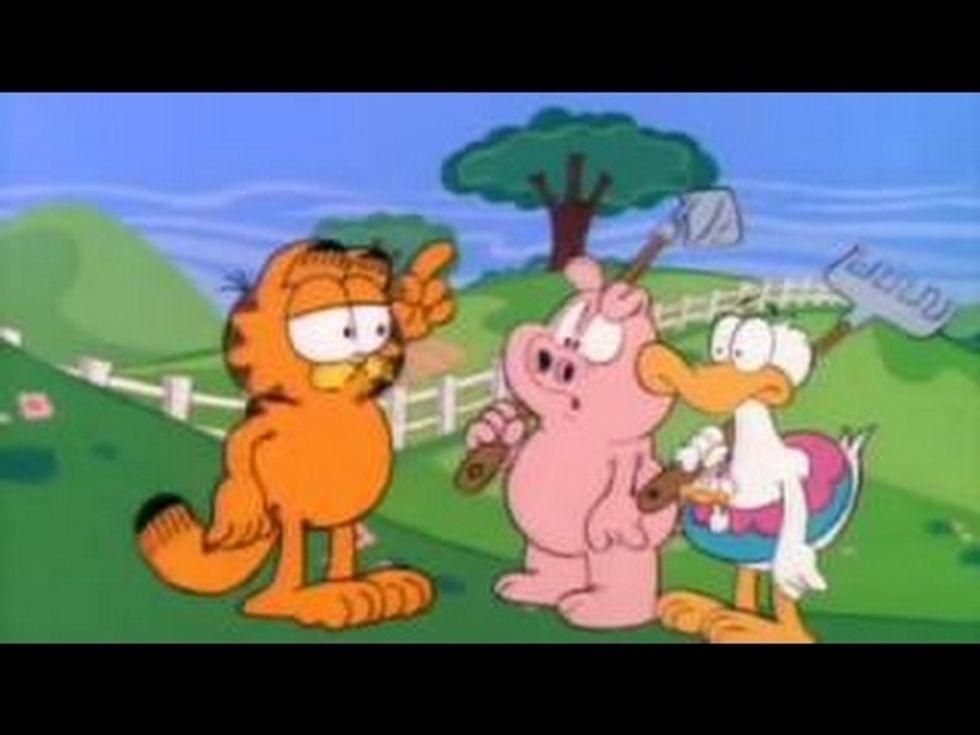I may be dating myself here, but I grew up reading the so-called 'funnies' about a million years ago, back when newspapers were free. My go-to's were 'Peanuts,' 'The Boondocks,' and 'Calvin and Hobbes.' I'd take quick glances at 'Garfield,' but, finding the subject matter neither charming nor particularly funny, would not linger. Garfield, though, has been a ubiquitous figure throughout pretty much everyone's childhood and adolescence. The familiar, rotund orange tabby has but cemented himself into the collective global consciousness. It feels like everyone on Earth has heard of or seen the character. Everyone knows the punchlines about lasagna and Mondays. Everyone has formulated their own theories about the exact level of telepathy occurring between Garfield and John, or Garfield and Odie. Everyone has heard the existential theories about John's insanity and subsequential terrifying hallucinations of a fat feline who regularly abuses him.
This was already puzzling to me, but then I learned that Garfield's intellectual property and merchandising generate over $1 billion in annual revenue.
How could this be? This was something I had always been unable, or, rather, unwilling, to wrap my head around. For one, Garfield was not good. It was not clever, not funny, not satirical, not particularly smart. I'd always found it bland at best and rather cynical at worst. It was also repetitive; jokes were recycled. Every week there was something about Mondays or lasagna. Following the strip made me feel like I was trapped in my own unique brand of hell. I was an adult when I discovered the animated series, 'Garfield & Friends,' which enjoyed a momentous run from 1988 to 1995. The title of the program perplexed me. Garfield and...friends? The show didn't at all seem to be about that. Garfield is an unrepentant, machiavellian grandiose narcissist, who is masochistic and manipulative. What exactly are we supposed to like about this character? His inoffensive, 'cute,' round design is misleading in this way; at first glance, one would assume that Garfield is huggable and loveable.
That's because Garfield's creator, Jim Davis, was ripping off Charles M. Schulz's iconic design of Snoopy. Snoopy, the round, pot-bellied, huggable, bipedal, stoic yet snappy, stylish dog, was a direct influence on the development of Garfield, and Mr. Davis openly admits to this, making no qualms about the fact that Garfield was conceived as a "good, marketable character." This is why the comic strip is unfunny, bland, non-satirical, non-political. This is why Garfield is a cat -- one of the most popular animals in existence -- to bank off the success of Snoopy's marketability. Garfield was designed from top to bottom to make money, not to have a heart, and it SHOWS.
I believe this sinister, money-grubbing gimmick is what I was picking up on when I read the comics as a kid and attempted to watch the animated series as an adult. The show just oozes incessant mean-spirited blandness, unfunny jokes, lazy animation, and a whole lot of humor centered around animal abuse. What exactly is supposed to be so funny, so charming, about a gluttonous, treacherous animal who takes pleasure in kicking a dog down the stairs?
And what's up with the merchandising anyway -- who is this even for? Is it for babies? Is it for boomers? It's certainly not for children, I mean, it's not like Garfield is any sort of model citizen. I actually can't imagine anyone genuinely enjoying this. The character design is not even cute. Garfield's spaghetti-like, overly malleable jowls are disconcerting, and his penchant for telepathic communication is highly unrelatable. And yet we all fell for it. Like obedient sheep, we're funneling $1 billion annually into this crap.
I'll take Snoopy over Garfield any day. I mean, Snoopy is also a bit of an A-hole, but at least he doesn't "talk."














